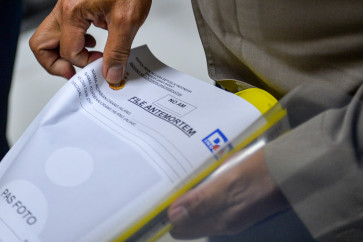Offshore loan rise signals economic pickup
A slight month-on-month (mom) rise in offshore loans in November 2015 may indicate the gradual beginning of an economic upturn
Change text size
Gift Premium Articles
to Anyone

A
slight month-on-month (mom) rise in offshore loans in November 2015 may indicate the gradual beginning of an economic upturn.
According to latest external debt statistics issued by Bank Indonesia (BI) on Monday, total loans rose by 0.3 percent to US$304.59 billion in November from the previous month.
In terms of economic sectors, monthly increases were recorded in the manufacturing and financial sectors, with manufacturing loans climbing 1.6 percent and financial loans growing by 1 percent.
BI Governor Agus Martowardojo said the increase was in line with November's data on imports, which also posted a monthly increase. 'We all know that we booked a trade deficit in November, with
imports higher than exports. Higher imports often suggest that the economy is on the rise,' he said, adding that the uptick in the external loans indicated financing needs for imports.
Separate data from the Central Statistics Agency (BPS) show that imports increased 3.6 percent to $11.51 billion in November from October. Imports of machinery, electrical equipment, iron and steel ' all of which are important components in manufacturing ' reported a monthly rise, according to the data.
Bank Central Asia (BCA) chief economist David Sumual agreed that the rise in offshore loans could be seen as a sign of an economic upturn. 'The rise in manufacturing loans is a positive because we do need to establish infrastructure across the country,' he said.
He also added that the weakening of the rupiah had made investing in Indonesia attractive, thus 'boosting demand for external loans'.
According to Samuel Asset Management economist Lana Soelistianingsih, external loans were inevitable for Indonesia because of domestic financing constraints.
'We have to admit that we do need external financing. As long as it's used for productive purposes, it can actually spur growth,' she said.
Lana expected to see fourth quarter growth to be higher than the 4.73 percent recorded in the third quarter, as economic activities gradually picked up steam.
Meanwhile, the external debt statistics reveal that the private sector still accounts for the largest portion of the total debt with 54.8 percent, followed by the public sector ' comprising the government and BI ' accounting for 45.2 percent.
Non-banking firms saw their debts rise 0.1 percent mom, while the government itself posted a 0.9 percent rise in loans during the same period.
In terms of maturity period, short-term loans reached $40.71 billion by the end of November and long-term stood at $263.88 billion.
Agus said the situation was still under control, even though short-term offshore debt accounted for 40.6 percent of the November foreign exchange (forex) reserves, which amounted to $100.2 billion.
'Short-term debt can consist of trade payables and loans from affiliates. We should not worry because they tend to be rolled over or revolving loans,' he said.
Meanwhile, at the end of November, the debt-to-GDP ratio amounted to 34.8 percent, a level that both Agus and David regarded as safely below the benchmark of 40 percent.
'What we need to work on is the forex reserves, finding new sources to boost reserves, while at the same time, maintaining the competitiveness of the rupiah exchange rate,' David said.
_____________________________
To receive comprehensive and earlier access to The Jakarta Post print edition, please subscribe to our epaper through iOS' iTunes, Android's Google Play, Blackberry World or Microsoft's Windows Store. Subscription includes free daily editions of The Nation, The Star Malaysia, the Philippine Daily Inquirer and Asia News.
For print subscription, please contact our call center at (+6221) 5360014 or subscription@thejakartapost.com









